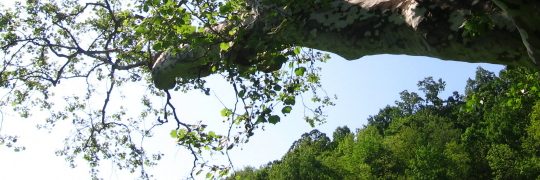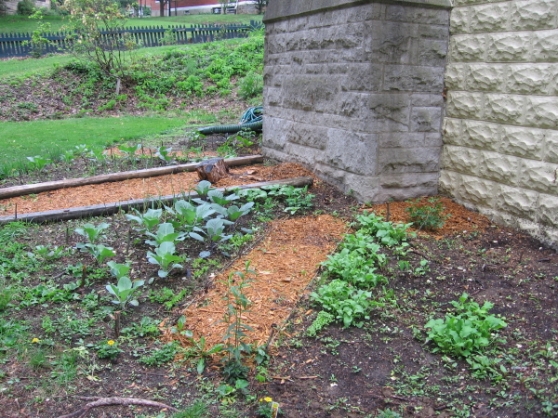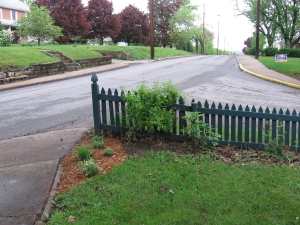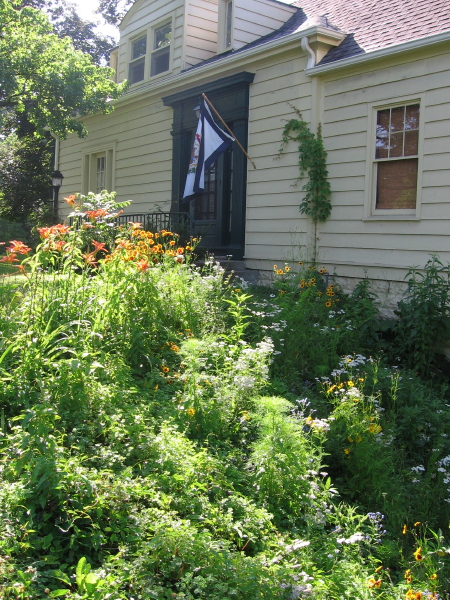 About 250 years since the first settlements west of the mountains, and 143 years after statehood, our new West Virginia flag flies above our cottage garden bank.
About 250 years since the first settlements west of the mountains, and 143 years after statehood, our new West Virginia flag flies above our cottage garden bank.
Category Archives: Gardening
First Harvest
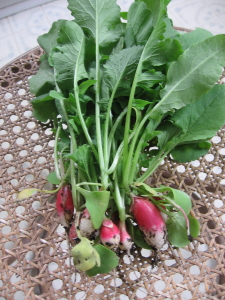 Radishes fresh from the kitchen garden. Perhaps whoever compiled the table of yields I used to decide how much to plant didn’t like radishes, or only intended radishes to be used one per salad as a garnish. I used this in a raita – or rather, used the raita dressing – yogurt with cumin, raisins, lime juice – as a dip. There will be enough radishes for garnish, but not to eat as a vegetable. Time to plant more.
Radishes fresh from the kitchen garden. Perhaps whoever compiled the table of yields I used to decide how much to plant didn’t like radishes, or only intended radishes to be used one per salad as a garnish. I used this in a raita – or rather, used the raita dressing – yogurt with cumin, raisins, lime juice – as a dip. There will be enough radishes for garnish, but not to eat as a vegetable. Time to plant more.
Progress of the Kitchen Garden
Theme Days in the Garden
Every day in the garden seems to have a theme, driven by the weather, the season, and sometimes by chance or whim. Spraying poison ivy must be done when it is dry and going to stay that way. Pulling weeds is easier after a rain. Second-year garlic mustard needs to be pulled before it blooms, but the seedlings are easier to pull once they are larger. This time of year, the vegetation is so enthusiastic that contemplating all the weeds at once is overwhelming. Concentrating on just one – pulling all the thistles, or dandelions, or dock, or curly dock, or garlic mustard – helps. Of course, each weed requires a slightly different style, too, so you can get into a rhythm rather than switching constantly. Garlic mustard is very satisfying because it can be pulled up easily with no implement at all. Dandelions pop right out with the implement I call a weeder and Robert calls an asparagus fork.
Last week, we started resetting the half of the stepping stones from the back porch to the back gate, which we hadn’t gotten to last spring, although we had uncovered them. I was digging out all the dandelions and plantains which were fast replacing the grass along the path, when our neighbor across the street came by and we talked for a bit. It got late, it rained, and days later, I couldn’t find the weeder. I was sure that was the last time I had it, but we both walked the entire yard looking for it. Grocery day came, we still hadn’t found it, and we stopped in Big Lots looking for something else entirely. There were weeders, these with a built-in lever, so we got one. I tackled the plantain, which has covered huge stretches, so much that a plantain theme day is not “All the plantain” but “All the plantain on the left side of the slope under the red maple.” The new weeder is much better for plantain, because of the better leverage, but I still wanted the old one because it is great for sticking in deep to find grown-over stone paving and stepping stones. We got back to finishing the back path, and there, right where I thought I had left it, but under the leaf mulch along the fence, Robert found the weeder.
Rhododendron
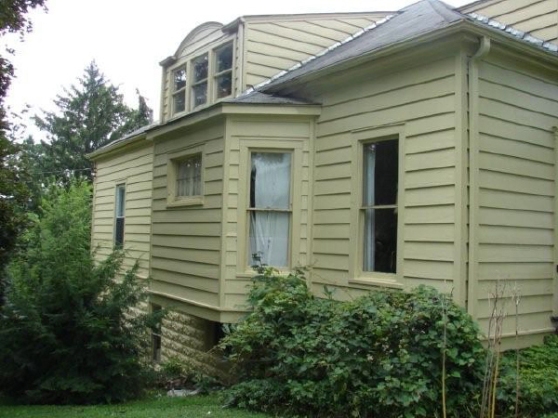 I thought the rhododendron at the northwest corner of the house was just badly situated, even though houses all along our street have thriving rhododendrons in the same position. Then I found this picture from the inspection. What appears to be a healthy mass of shrubbery here is actually several rhododendrons completely covered in grape vines, and sharing the space with box elder volunteers. (You can also see the sun gleaming on the old flashing.) I don’t remember, but Robert must have removed the grape vines in the first great clearance project.
I thought the rhododendron at the northwest corner of the house was just badly situated, even though houses all along our street have thriving rhododendrons in the same position. Then I found this picture from the inspection. What appears to be a healthy mass of shrubbery here is actually several rhododendrons completely covered in grape vines, and sharing the space with box elder volunteers. (You can also see the sun gleaming on the old flashing.) I don’t remember, but Robert must have removed the grape vines in the first great clearance project.
Last year, I waited impatiently to see if it was a native rhododendron (which is the state flower), or one of the Himalayan imports, many of which are a fluorescent lavender that I find garish. There were just two clusters of blooms, on nearly naked branches, and they were the pale pink and white of the species, although this is probably a hybrid or named cultivar. There has not been a tremendous burst of foliage, but there are a dozen or more bloom clusters this spring. We will leave it be and see how it does; it is visible from the front parlor, where Robert has his desk, and the library.
Last spring we planted half a dozen under the spruces and hemlocks at the back edge of the property, where they seemed to be happy. The deer were delighted, and ate them down to twigs. At least two survived, barely, but won’t be blooming this year.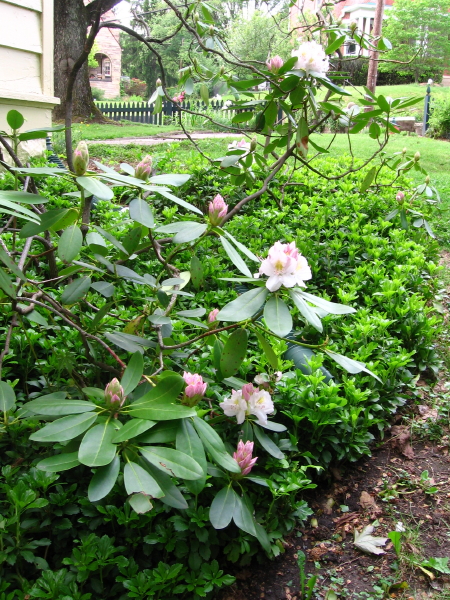
Azalea
 The flame azalea is blooming. Last year, I was eager to see what it was; it was clearly a native deciduous azalea, but what color? The twisting branches are interesting, but a little sparse most of the year. The glowing orange in the spring is wonderful. The photograph doesn’t do it justice, and doesn’t capture the scent, like that of other honeysuckles.
The flame azalea is blooming. Last year, I was eager to see what it was; it was clearly a native deciduous azalea, but what color? The twisting branches are interesting, but a little sparse most of the year. The glowing orange in the spring is wonderful. The photograph doesn’t do it justice, and doesn’t capture the scent, like that of other honeysuckles.
The Postbox Garden
 When we moved in, we had a good bit of important mail expected, like our first pension payments, which for reasons we still don’t understand, had to be mailed rather than direct-deposited. We had been looking forward to mail through the brass mail-slot, an old-fashioned thing we had previously only seen in movies. But alas, the postman slipped only one item through that slot – a notice that we had to have a mailbox by the sidewalk. We put it in this rather grubby corner at the front gate. In March, deliveries stopped, and eventually resumed by the end of May, after the incident got AP coverage which was picked up worldwide.
When we moved in, we had a good bit of important mail expected, like our first pension payments, which for reasons we still don’t understand, had to be mailed rather than direct-deposited. We had been looking forward to mail through the brass mail-slot, an old-fashioned thing we had previously only seen in movies. But alas, the postman slipped only one item through that slot – a notice that we had to have a mailbox by the sidewalk. We put it in this rather grubby corner at the front gate. In March, deliveries stopped, and eventually resumed by the end of May, after the incident got AP coverage which was picked up worldwide.
Along about then, we dug up the weeds by the gate, and planted a little garden: lavender, yarrow, a daylily, and some iris transplanted from the bottom of the garden, where they were languishing in heavy shade. The lavender flourished, blooming all summer, staying beautifully blue-green all winter, and surviving the snow and the chemicals from the removal thereof. The scent is a pleasure when going past or checking the mail.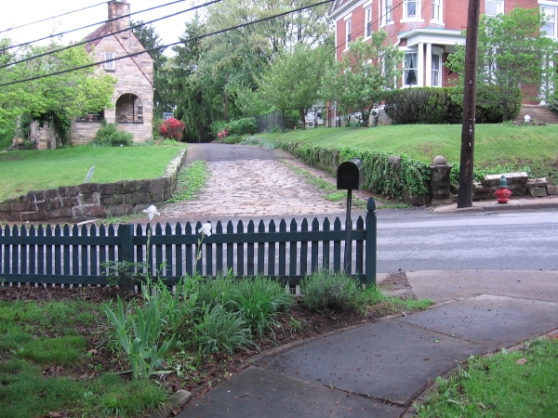
Now the iris are blooming, the lavender and yarrow are putting out new leaves, and we have added another patch of lavender, yarrow, and daylily on the other side of the gate, with another iris we found still languishing.
The Kitchen Garden
 We will see whether this should be called a potager – everything sounds better in French, but it may not be as pretty as a French kitchen garden. Last year, we had two tomatoes and a few basil plants, plus some lettuce and peas planted along the back porch where the peas could climb the trellis. This turned out to be theoretical, because the gutters were in such disrepair that the water just poured over the edge of the roof and created a small swamp in the peas and lettuce. We did have two volunteer lettuces in the bed this spring, from seed that didn’t sprout or get washed away last year, I assume. We also planted spinach and chard along the back walk, which must have been overcome by the plantain, dandelions, et al, because they never became apparent. The deer ate the tomatoes – the plants, not the fruit, of which there was none.
We will see whether this should be called a potager – everything sounds better in French, but it may not be as pretty as a French kitchen garden. Last year, we had two tomatoes and a few basil plants, plus some lettuce and peas planted along the back porch where the peas could climb the trellis. This turned out to be theoretical, because the gutters were in such disrepair that the water just poured over the edge of the roof and created a small swamp in the peas and lettuce. We did have two volunteer lettuces in the bed this spring, from seed that didn’t sprout or get washed away last year, I assume. We also planted spinach and chard along the back walk, which must have been overcome by the plantain, dandelions, et al, because they never became apparent. The deer ate the tomatoes – the plants, not the fruit, of which there was none.
When stripping the last English ivy (well, the last large area – we will never see the last of it), I realized that, with the sweet gum gone, the area around the chimney got the most sun. So we planned a kitchen garden. The area is very visible from the street, so it needed to look good, and I have been wanting an ornamental vegetable garden ever since running across The Art of French Vegetable Gardening when we were still in Austin. We discussed what we wanted to eat, I found a vegetable planting and rotation plan in the excellent The Garden Planner, edited by a Gardener Royal (and out of print, I think), and we eventually laid out the garden, just at planting time, and the day before the roofers showed up. So we had a two-week wait.
 Last week, though, we got cabbage plants (three kinds) and onion sets, in addition to the seeds we had already chosen, and planted the whole thing – carrots, radishes, beets, turnips, onions, leeks, carrots, parsnips, cabbages, spinach, chard, sugar peas, pole beans, rocket, and five different lettuces. We tucked in the horseradish root cousin Fred gave us last winter. Next week we’ll add the warm weather plants – tomatoes, peppers, basil, eggplant, cucumbers, and squash. We’re still debating potatoes.
Last week, though, we got cabbage plants (three kinds) and onion sets, in addition to the seeds we had already chosen, and planted the whole thing – carrots, radishes, beets, turnips, onions, leeks, carrots, parsnips, cabbages, spinach, chard, sugar peas, pole beans, rocket, and five different lettuces. We tucked in the horseradish root cousin Fred gave us last winter. Next week we’ll add the warm weather plants – tomatoes, peppers, basil, eggplant, cucumbers, and squash. We’re still debating potatoes.
We planted two yellow climbing roses on either side of the chimney, and we will add nasturtiums, marigolds, and maybe a lavender border, for pretty. Herbs will go out back, just off the back porch, where we were pleased to find last year’s oregano still flourishing, along with chives and parsley.
Native Ground Covers
Our yard had been sadly neglected for years when we bought the house less than two years ago. Besides what must have been the world’s largest stand of poke weed, there were poison ivy vines the size of my wrist climbing several of the Norway spruces, where they were basking in the sun, blooming madly, and dropping seeds everywhere. There were grape vines, even larger, regarding everything vertical in the yard as an arbor. Underneath it all was English ivy, and scattered here and there were volunteer box elders, maple and sweet gum seedlings, and graceful stands of garlic mustard, which is unfortunately an invasive European plant which exudes chemicals to discourage everything else. Field bindweed enjoyed the sunny slope in the front, amongst the ivy, both English and poison, and climbed the lone native flame azalea. Dandelions, of course, were everywhere, but at least they are edible. A bit of lawn had been kept mowed at the front and side, slowly disappearing under the creeping English ivy. In general, the property was a great example of disturbed land returning to nature.
I spent a morning last week walking the yard and spraying the remaining poison ivy, at least what I could find. Half an acre is a lot to comb for anything. Right now it is leafing out, and the shiny burgundy of the new leaves is relatively easy to spot among the Virginia creeper (which sometimes has only three leaves at first, but they are greener and fuzzy when you look closely) and box elder seedlings. I don’t generally believe in herbicides, but cutting the vines doesn’t kill the roots, which just cheerily send up new shoots, and doing anything that requires touching it is fraught. I had a good bit on my arms last year, just from not seeing the vines when pulling English ivy. Robert unfortunately carried a good many loads of dead leaves and vines in his arms and ended up with solid blisters.
 We use a push mower, for exercise, saving the planet from two-cycle exhaust and noise, and old-fashioned charm. So we would just as soon keep the lawn to a minimum, and most of our half-acre is shaded, sloping or both. Hence our strategy, which allows us to feel both morally superior and frugal. Encourage the prettiest low-growing “weeds”, pull out the rest, and call it “native ground cover.” Here is a slope of ground-ivy and white violets under one of our Norway spruces. There is some corn speedwell, too. Earlier, common blue violets were blooming here. Ground-ivy (also called gill-over-the-ground or creeping Charlie), is officially a weed, but it grows in shade, responds nicely to mowing or looks fine without, and blooms from March until past midsummer. It is lovely to me by itself or in the lawn.
We use a push mower, for exercise, saving the planet from two-cycle exhaust and noise, and old-fashioned charm. So we would just as soon keep the lawn to a minimum, and most of our half-acre is shaded, sloping or both. Hence our strategy, which allows us to feel both morally superior and frugal. Encourage the prettiest low-growing “weeds”, pull out the rest, and call it “native ground cover.” Here is a slope of ground-ivy and white violets under one of our Norway spruces. There is some corn speedwell, too. Earlier, common blue violets were blooming here. Ground-ivy (also called gill-over-the-ground or creeping Charlie), is officially a weed, but it grows in shade, responds nicely to mowing or looks fine without, and blooms from March until past midsummer. It is lovely to me by itself or in the lawn.
Just Like That
It is spring. Never mind the solstices; Robert and I agree that March, April, and May are the spring months; summer starts on Memorial Day weekend and ends on Labor Day. There are some small patches of snow left in the dark corners of the yard, but it is 72° and sunny, and there are robins. Other people’s crocuses are blooming; ours again this year are just leaves.
Yesterday Robert cleaned up the broken bits of fence from the car-in-the-yard incident New Year’s weekend. There had been snow cover ever since then, too much to clean up the pickets which were scattered everywhere.
We had lunch on the patio, which has a view of the largest patch of English ivy that I didn’t get to last spring. It was irresistible, and I managed to remember to keep my wrists straight most of the time. I was hoping it was weakened by three months of cold and snow, and would give up easily. I did manage to pull out almost half of it, while Robert picked up sticks and raked leaves that had appeared from who knows where over the winter, since the lawn was clear before the snow. While ripping it up, I realized that it is probably the only level area on the property that gets 6 hours of sun, other than the strip along the front fence. So we will try our vegetable garden there this year. Perhaps something very French with boxwood borders.
